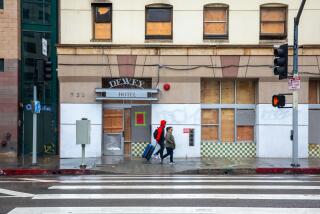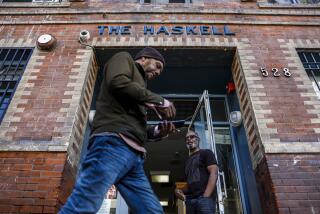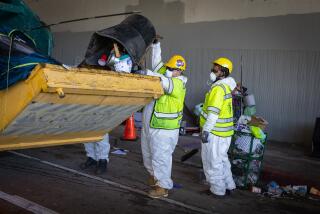Enabling homelessness on L.A.’s skid row
A federal judge last year issued a preliminary injunction against the city of Los Angeles, effectively allowing anyone in the area around skid row to store personal belongings — including mattresses, overflowing plastic bags and shopping carts — on the sidewalks.
The ruling by U.S. District Judge Philip Gutierrez was intended to protect the possessions of homeless and street people, and to prevent them from being mistaken for garbage and removed from the public sidewalks.
As a predictable — if unintended — consequence of that ruling, hundreds of people have transformed the streets of skid row and surrounding neighborhoods into their personal storage facilities. And with the growing piles have come disease, vermin and crime.
These conditions could soon be extended across Los Angeles when a federal appeals court issues a permanent order. Santa Monica civil rights attorney Carol Sobel, who brought the original lawsuit, has argued that the injunction should be applied throughout Los Angeles, and last month she brought a second lawsuit seeking a similar injunction in Venice.
If she’s successful, Venice and other neighborhoods can expect the same conditions that The Times described in a story about skid row last week.
On block after block, the sidewalks have been taken over by people leaving heaps of material that in most contexts would be considered garbage. Rats can be seen scurrying among the piles. Thefts have gone up 46% in the year since the injunction.
The judge issued his order to protect people living on the streets, but having observed it in action, I’d say they have been harmed by it. They are most often the victims of the increase in crime, and the fact that it is now legal to live on the streets surrounded by possessions has meant that some homeless people who might have sought help in getting housing aren’t doing so.
But the homeless aren’t the injunction’s only victims. The increased filth that has resulted from it also lowers the quality of life for residents, workers, business owners and visitors.
Restaurants, bars, nightclubs and retailers have to deal with overflowing shopping carts parked on the sidewalks in front of their establishments, which prevents some customers from entering and others from returning.
One restaurant just off skid row now spends $12,000 per month — nearly as much as it pays in rent — on private security to keep aggressive panhandlers from bothering people on its patio and to discourage shoplifting.
An office building owner recently lost a potential $620,000 lease when the prospective tenant visited the building at night and saw the encampments.
Business owners report that when visitors have to step over trash and worse to get inside, stores, restaurants and clubs see a drop in sales. Occupancy rates in office buildings sink when employers don’t feel safe and move out. Jobs are lost or never created because of concerns over the health and safety of workers.
We all have concern for those whose circumstances have led them to skid row. But the majority of those taking advantage of this injunction are not on the streets because of the recent economic troubles. Rather they are seriously mentally ill or drug addicted, and most of them have resisted efforts to house them.
Rather than simply establishing and refining rules under which homeless people can continue to live on city sidewalks in squalor, shouldn’t activists and the courts focus on how to help homeless people off the streets? Protecting deplorable conditions by court order is tantamount to condemning the unfortunate to a lifetime of slow, deliberate deterioration.
Meanwhile, the rights of a few to leave their possessions on public property have trumped the rights of the many who need to use the sidewalks for their intended purpose without threat to their health and safety.
The recent deterioration of skid row is particularly troubling because, in recent years, conditions in the area had been improving. The police, through the Safer City Initiative, had taken a hard stance on enforcing the law. Crime had dropped, unhealthful conditions were being cleaned up and the population on skid row sidewalks had plummeted.
Now police say they feel somewhat powerless. Picking up the wrong material from sidewalks could lead to costly lawsuits. Determining just what is and what isn’t garbage is not as easy as it sounds, given the vague terms of the injunction and the conditions on skid row.
The court will soon issue a final order in this case. And when it does, we will have either an endorsement for the rule of law or another well-intended, but misguided, ruling that protects unlawful conduct for a few and ignores the ramifications for the rest of us.
If the court of appeals affirms Judge Gutierrez’s injunction, watch where you walk.
Carol Schatz is president and chief executive of the Central City Assn.
More to Read
A cure for the common opinion
Get thought-provoking perspectives with our weekly newsletter.
You may occasionally receive promotional content from the Los Angeles Times.






